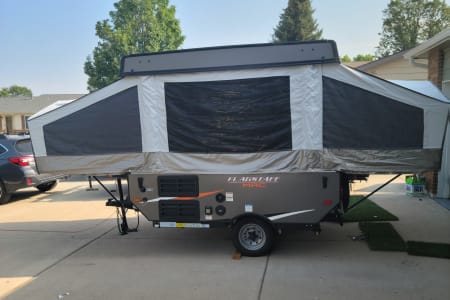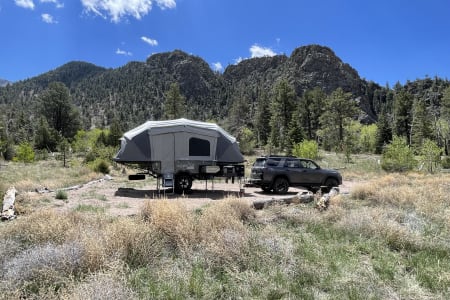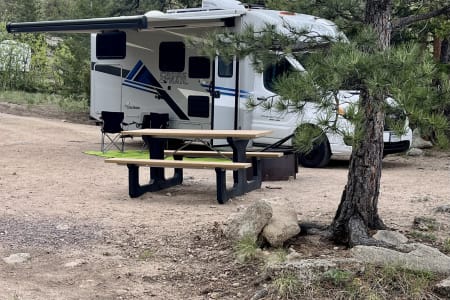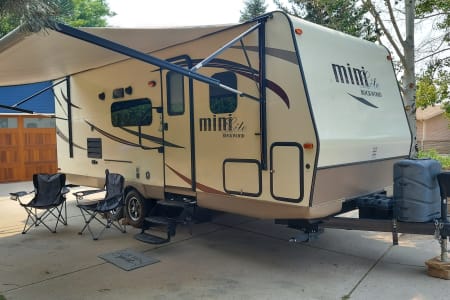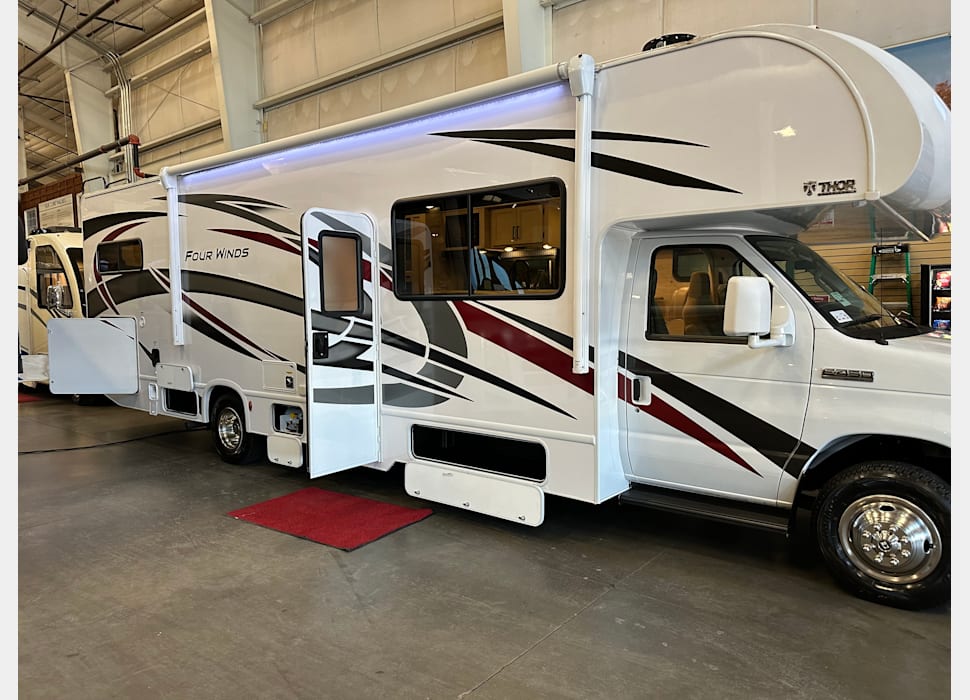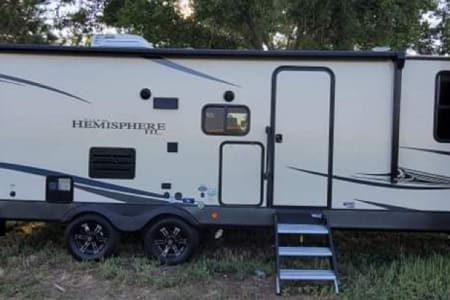Rocky Mountain National Park Colorado (CO) RV Rentals
RV Rentals Dates
RV Rentals near Rocky Mountain National Park?
Introduction
Rocky Mountain National Park is a haven for outdoor enthusiasts and nature lovers, offering a perfect spot for RV camping. Its rich history, cultural significance, unique geological features, and diverse range of recreational activities make it a must-visit destination for RV renters.
The history and cultural significance of Rocky Mountain National Park date back thousands of years. Native American tribes, such as the Ute and Arapaho, have long considered these mountains sacred and have left behind traces of their presence in the form of petroglyphs and artifacts. In 1915, the park was established, making it one of the oldest national parks in the United States. Today, it stands as a testament to the preservation of natural beauty and cultural heritage.
RVThereYet.com is an RV rental company, offering a diverse fleet of motorhomes, including Class A, Class B, and Class C Rentals, Travel, Trailers, and Motorhomes for unforgettable adventures in scenic RV parks and campsites in Rocky Mountain National Park. Ensure early reservations for camper rentals at Rocky Mountain National Park.
Transportation
-
Driving/Transportation
When visiting Rocky Mountain National Park, private vehicle travel is the most convenient option for transportation. The park can be accessed from multiple entrances, including the Beaver Meadows Entrance, Fall River Entrance, and Grand Lake Entrance. Each entrance provides easy access to different areas of the park, allowing visitors to explore its diverse landscapes. It’s important to note that there are restrictions on rig sizes within the park, with a maximum length of 40 feet and a maximum combined vehicle and trailer length of 35 feet. RV renters should ensure their vehicle meets these requirements before entering the park.
-
Parking area
Rocky Mountain National Park offers designated RV parking areas throughout the park making it convenient for RV travelers. However overnight parking outside of designated campsites is not permitted. It is highly recommended to camp with an RV in the park and explore using alternative transportation methods such as shuttle buses or hiking trails. This allows for a more immersive experience and reduces traffic congestion within the park. Be sure to check the park’s website for information on RV camping reservations and availability.
-
Public Transportation
Rocky Mountain National Park offers a convenient shuttle bus system that allows visitors to explore the park without the need for their own vehicle. The shuttle buses provide transportation to popular destinations within the park including trailheads and scenic viewpoints. Additionally the park has a network of walking paths that offer a scenic and eco-friendly way to navigate the park’s attractions. These options provide visitors with easy access to the park’s beauty while minimizing traffic and environmental impact.
Top Campsites in Rocky Mountain National Park
-
Reservations camping
Moraine Park Campground
Located within Rocky Mountain National Park Moraine Park Campground is the most popular choice for campers. With 244 sites it offers a variety of amenities including fire pits picnic tables and restrooms. The campground is pet-friendly and open from May to October. It can accommodate RVs and trailers up to 40 feet in length. Activities in the area include hiking wildlife viewing and fishing in the nearby Moraine Park.
Glacier Basin Campground
Situated in the heart of Rocky Mountain National Park Glacier Basin Campground is another highly sought-after campground. It features 150 sites with access to water picnic tables and fire rings. The campground is open from June to September and allows RVs and trailers up to 35 feet in length. Popular activities include hiking to nearby glaciers birdwatching and stargazing.
Estes Park KOA
Located just outside the park in Estes Park the Estes Park KOA offers a comfortable camping experience. With 215 sites it provides amenities such as full hookups Wi-Fi and a camp store. The campground is pet-friendly and open year-round. RVs and trailers of all sizes are welcome. Activities at the KOA include swimming in the heated pool mini-golf and exploring nearby hiking trails.
Spruce Lake RV Resort
Situated in Estes Park Spruce Lake RV Resort is a popular choice for RV campers. It offers 129 spacious sites with full hookups picnic tables and fire rings. The resort is pet-friendly and open from May to October. RVs and trailers up to 45 feet in length are permitted. Amenities include a clubhouse laundry facilities and a playground. Nearby activities include fishing boating and horseback riding.
These top campgrounds and KOAs near Rocky Mountain National Park provide a range of amenities and activities for campers to enjoy. Whether you prefer a rustic camping experience within the park or a more comfortable stay just outside there’s something for everyone. Be sure to make reservations in advance as these popular sites tend to fill up quickly during peak seasons.
-
First-come first-served
Timber Creek Campground
Located on the west side of Rocky Mountain National Park Timber Creek Campground offers 98 first-come-first-served sites. It is open from late May to early September. The campground can accommodate RVs and trailers up to 30 feet in length. Amenities include picnic tables fire rings and vault toilets. Timber Creek Campground is pet-friendly so you can bring your furry friends along for the adventure.
Longs Peak Campground
Situated near the base of Longs Peak this campground offers 26 first-come-first-served sites. It is open from early July to late September. The campground can accommodate RVs and trailers up to 40 feet in length. Facilities include picnic tables fire rings and vault toilets. Please note that there are no hookups available at this campground. Longs Peak Campground is pet-friendly allowing you to enjoy the outdoors with your four-legged companions.
Aspenglen Campground
Nestled in a beautiful aspen grove Aspenglen Campground offers 54 first-come-first-served sites. It is open from late May to early September. The campground can accommodate RVs and trailers up to 30 feet in length. Amenities include picnic tables fire rings and vault toilets. Aspenglen Campground is pet-friendly so you can bring your furry friends along for a memorable camping experience.
These first-come-first-served campgrounds in Rocky Mountain National Park provide a great opportunity for spontaneous camping trips. Keep in mind that availability is on a first-come-first-served basis so it’s best to arrive early to secure a site especially during peak seasons. Enjoy the beauty of the park and the convenience of these campgrounds and don’t forget to check the park’s website for any updates or changes in availability.
-
Alternate camping
Private Campgrounds
If the campsites inside Rocky Mountain National Park are full there are several private campgrounds nearby that offer alternative camping options. Estes Park the gateway town to the park has a variety of private campgrounds that cater to RV renters. These campgrounds often provide amenities such as full hookups showers and laundry facilities. Some popular private campgrounds in the area include Spruce Lake RV Resort and Estes Park KOA. These campgrounds offer a comfortable and convenient camping experience allowing RV renters to still enjoy the beauty of the Rocky Mountains.
Backcountry Camping
For those seeking a more adventurous camping experience backcountry camping is an option to consider. Rocky Mountain National Park offers designated backcountry campsites that can be accessed through hiking trails. Permits are required for backcountry camping and can be obtained from the park’s visitor centers. Keep in mind that backcountry camping requires more preparation and self-sufficiency as there are no amenities or facilities available. However it provides an opportunity to immerse yourself in the wilderness and enjoy the solitude of the park’s remote areas.
These alternative camping options near Rocky Mountain National Park provide flexibility for RV renters when campsites inside the park are full. Whether you choose to stay at a private campground with modern amenities or embark on a backcountry adventure there are options available to suit different preferences and camping styles. Remember to plan ahead make reservations if necessary and always follow the rules and regulations of the campgrounds or backcountry areas you choose to explore.
-
General activities
Hiking
Hiking is the most popular activity in Rocky Mountain National Park offering a multitude of trails for all skill levels. From easy nature walks to challenging summit hikes there’s something for everyone. One iconic hike is the trail to Alberta Falls a picturesque waterfall located near the Glacier Gorge trailhead. Another must-visit is the Sky Pond trail which takes you through alpine meadows and rewards you with stunning views of the surrounding peaks.
Fishing
With its pristine lakes and rivers Rocky Mountain National Park is a paradise for fishing enthusiasts. The park offers opportunities to catch trout salmon and other fish species. One popular fishing spot is the Big Thompson River known for its abundance of brown and rainbow trout. Another great location is Bear Lake where you can fish for cutthroat trout while enjoying the breathtaking mountain scenery.
Wildlife Viewing
Rocky Mountain National Park is home to a diverse array of wildlife including elk moose bighorn sheep and black bears. Many visitors come to the park in hopes of spotting these magnificent creatures in their natural habitat. The best areas for wildlife viewing include Moraine Park Horseshoe Park and Upper Beaver Meadows. Remember to maintain a safe distance and observe wildlife from a respectful distance.
Cycling
Cycling enthusiasts can explore the park’s scenic roads and challenging mountain passes on two wheels. Trail Ridge Road the highest continuous paved road in the United States offers an exhilarating cycling experience with stunning views of the surrounding mountains. Another popular cycling route is the Old Fall River Road a historic gravel road that winds through alpine landscapes and offers a more rugged biking experience.
Scenic Drives
For those who prefer a more leisurely way to enjoy the park’s beauty scenic drives are a popular choice. Trail Ridge Road a designated All-American Road showcases the park’s diverse landscapes as it winds through high alpine tundra and offers breathtaking views. The Bear Lake Road on the other hand provides access to several trailheads and stunning viewpoints including the famous Dream Lake and Emerald Lake.
These popular recreational activities in Rocky Mountain National Park attract outdoorsy RV campers from all over the world. Whether you’re hiking to breathtaking waterfalls casting your line into crystal-clear lakes or simply enjoying the scenic drives there’s no shortage of adventures to be had in this stunning national park.
-
Alternative activities
Scenic Drives
For RV campers who prefer a more relaxed way to enjoy the beauty of Rocky Mountain National Park scenic drives are a popular choice. Trail Ridge Road the highest continuous paved road in the United States offers stunning panoramic views of the surrounding mountains and valleys. Another scenic drive is the Bear Lake Road which takes you to several picturesque viewpoints and trailheads.
Wildlife Viewing
Rocky Mountain National Park is teeming with wildlife making it a prime destination for nature enthusiasts. RV campers can enjoy spotting elk mule deer and even the elusive mountain lion. Popular areas for wildlife viewing include Moraine Park Horseshoe Park and Upper Beaver Meadows. Remember to bring binoculars and observe wildlife from a safe distance.
Nature Photography
With its breathtaking landscapes and diverse wildlife Rocky Mountain National Park is a paradise for nature photographers. Capture the stunning reflections in the mirror-like waters of Bear Lake or the vibrant wildflowers blooming in the alpine meadows. The park offers endless opportunities for Instagram-worthy photos from majestic mountain peaks to delicate waterfalls.
Scenic Picnic Spots
RV campers can enjoy a leisurely picnic surrounded by the park’s natural beauty. Many areas within the park such as Sprague Lake and Lily Lake offer picnic tables and breathtaking views. Pack a delicious lunch soak in the tranquil atmosphere and savor the beauty of Rocky Mountain National Park.
Visitor Centers and Museums
For those seeking a deeper understanding of the park’s natural and cultural history the visitor centers and museums in Rocky Mountain National Park provide fascinating insights. The Beaver Meadows Visitor Center offers exhibits on the park’s ecology and geology while the Moraine Park Discovery Center showcases the park’s wildlife. RV campers can learn about the park’s rich heritage and gain a greater appreciation for its natural wonders.
These alternative recreational activities in Rocky Mountain National Park cater to RV campers who prefer a more relaxed and leisurely experience. Whether you’re taking in the scenic drives capturing stunning nature photos or enjoying a peaceful picnic there are plenty of options to enjoy the park’s beauty without engaging in more physically demanding activities.
Season-specific experiences in Rocky Mountain National Park
-
Spring activities
Wildflower Viewing
Spring brings an explosion of color to Rocky Mountain National Park as wildflowers blanket the meadows and hillsides. Hike along the Cub Lake Trail to witness a stunning display of wildflowers including columbines lupines and paintbrushes. The Bear Lake Nature Trail is another great spot to see the vibrant blooms. Immerse yourself in the beauty of nature and capture stunning photos of these delicate and colorful flowers.
Historical Sites
Explore the rich history of Rocky Mountain National Park by visiting its historical sites. The Holzwarth Historic Site located along the Colorado River offers a glimpse into the life of early homesteaders in the area. Take a guided tour of the historic buildings and learn about the challenges they faced. The Kawuneeche Visitor Center situated near the site provides further insights into the park’s history and cultural heritage.
Waterfall Hikes
Spring is the perfect time to witness the power and beauty of waterfalls in Rocky Mountain National Park. The Alberta Falls Trail is a popular choice offering a moderate hike that leads to a picturesque waterfall surrounded by lush greenery. Another must-visit is the Ouzel Falls Trail which rewards hikers with breathtaking views of cascading waterfalls and the surrounding mountains.
Wildlife Photography
Spring is a great time to capture stunning wildlife photos in Rocky Mountain National Park. As the snow melts and the vegetation comes to life animals become more active. Keep your camera ready to photograph elk grazing in the meadows or bighorn sheep perched on rocky cliffs. The Moraine Park area and the Trail Ridge Road are prime locations for wildlife photography.
Trail Ridge Road Scenic Drive
As the snow begins to melt Trail Ridge Road opens up allowing RV campers to embark on a scenic drive through the park’s high alpine landscapes. This iconic road offers breathtaking views of snow-capped peaks alpine meadows and wildlife. Stop at the Many Parks Curve viewpoint for a panoramic vista of the surrounding mountains and valleys.
These springtime activities in Rocky Mountain National Park offer RV campers the opportunity to witness the beauty of wildflowers explore the park’s history and capture stunning photographs. Whether you’re hiking to waterfalls immersing yourself in the park’s rich heritage or embarking on a scenic drive there’s something for everyone to enjoy during this vibrant season.
-
Summer activities
Alpine Lake Hiking
Summer is the perfect time to embark on a hike to one of the alpine lakes in Rocky Mountain National Park. The Emerald Lake Trail is a popular choice offering a moderately challenging hike that rewards you with stunning views of the surrounding peaks and the shimmering turquoise waters of Emerald Lake. Another must-visit is the Sky Pond Trail which takes you through lush meadows and rocky terrain before reaching the breathtaking Sky Pond nestled beneath towering cliffs.
Camping and Stargazing
Summer nights in Rocky Mountain National Park offer a spectacular opportunity for stargazing. Set up camp at one of the park’s campgrounds and witness the breathtaking night sky free from light pollution. Moraine Park Campground and Glacier Basin Campground are popular choices for stargazing enthusiasts. Marvel at the Milky Way spot constellations and enjoy the tranquility of the park under a blanket of stars.
Fly Fishing
Summer is an excellent time for fly fishing in Rocky Mountain National Park. The park’s lakes and rivers are teeming with trout making it a paradise for anglers. The Big Thompson River is a popular spot for fly fishing known for its abundance of brown and rainbow trout. The Roaring River and Fern Lake are also great options. Cast your line and enjoy the peacefulness of the park while waiting for a bite.
Horseback Riding
Explore the beauty of Rocky Mountain National Park on horseback. Several stables in the area offer guided horseback riding tours that take you through scenic trails and meadows. Traverse the park’s diverse landscapes while enjoying the company of these gentle animals. Horseback riding is a unique and memorable way to experience the park’s natural beauty and connect with its rich history.
Wildlife Safaris
Summer is a great time to embark on a wildlife safari in Rocky Mountain National Park. Join a guided tour or rent a pair of binoculars and explore the park’s diverse ecosystems in search of wildlife. Keep an eye out for elk moose bighorn sheep and other fascinating creatures. The park’s meadows and valleys are particularly rich in wildlife during the summer months.
These summer activities in Rocky Mountain National Park offer RV campers a chance to explore the park’s stunning alpine lakes enjoy the beauty of the night sky engage in fly fishing adventures experience the park on horseback and go on wildlife safaris. Whether you’re seeking outdoor adventures or peaceful moments in nature the park has something to offer for everyone during the summer season.
-
Fall activities
Fall Foliage Hikes
Fall is a magical time in Rocky Mountain National Park as the leaves transform into vibrant shades of red orange and gold. Take a hike along the Bierstadt Lake Trail where you’ll be surrounded by a stunning display of fall colors reflected in the serene lake. The Cub Lake Trail is another great option offering breathtaking views of the changing foliage as you make your way through the forest.
Wildlife Rutting Season
Fall is the rutting season for elk making it an exciting time to witness their mating rituals. Head to Moraine Park or Horseshoe Park where you can observe male elk bugling and competing for the attention of females. Keep a safe distance and enjoy the spectacle of nature as these majestic animals display their strength and dominance.
Photography Expeditions
Fall in Rocky Mountain National Park provides endless opportunities for stunning nature photography. Capture the reflection of golden aspens in the calm waters of Bear Lake or frame the majestic elk against a backdrop of colorful foliage. The park’s diverse landscapes and vibrant colors make it a paradise for photographers of all skill levels.
Scenic Drives
Take a leisurely drive through Rocky Mountain National Park and witness the breathtaking fall colors at every turn. The Trail Ridge Road offers panoramic views of the surrounding mountains and valleys with the added bonus of fall foliage. The Old Fall River Road is another scenic route that winds through aspen groves and offers stunning vistas of the changing landscape.
Wildlife Watching
Fall is a great time for wildlife watching in Rocky Mountain National Park. As the animals prepare for winter they become more active and visible. Look out for bighorn sheep scaling rocky cliffs or mule deer grazing in meadows. The park’s valleys and meadows are ideal locations for spotting wildlife during this season.
These fall activities in Rocky Mountain National Park allow RV campers to experience the beauty of the changing foliage witness the fascinating elk rutting season capture stunning photographs enjoy scenic drives and observe wildlife in their natural habitat. Embrace the crisp air and vibrant colors of fall as you explore the park’s wonders during this enchanting season.
-
Winter activities
Snowshoeing and Cross-Country Skiing
Winter transforms Rocky Mountain National Park into a winter wonderland offering opportunities for snowshoeing and cross-country skiing. Explore the park’s trails on snowshoes such as the Bear Lake Trail or the Fern Lake Trail and immerse yourself in the peacefulness of the snowy landscape. Cross-country skiing is also a popular activity with trails like the Glacier Basin Loop providing scenic routes for all skill levels.
Wildlife Tracking
Winter is an excellent time to track wildlife in the park’s snowy terrain. Look for animal tracks along the trails and try to identify the footprints of elk deer foxes and other creatures. The park’s meadows and valleys are particularly rich in wildlife during the winter months offering a unique opportunity to observe their behavior in a snowy setting.
Winter Photography
Capture the stunning beauty of Rocky Mountain National Park in winter through photography. The snow-covered landscapes frozen lakes and snow-dusted trees create a magical atmosphere. Take your camera and explore the park’s scenic spots such as Dream Lake or Sprague Lake to capture breathtaking winter scenes.
Winter Wildlife Safaris
Join a guided wildlife safari tour to observe animals in their winter habitats. Knowledgeable guides will take you to the best spots for spotting elk bighorn sheep and other wildlife. Learn about their winter survival strategies and get a chance to capture remarkable photographs of these majestic creatures in the snowy landscape.
Ice Climbing
For the adventurous RV campers winter offers the opportunity to try ice climbing in Rocky Mountain National Park. The park’s frozen waterfalls and ice formations provide a challenging and thrilling experience for climbers of all levels. If you’re new to ice climbing consider hiring a guide who can provide instruction and ensure your safety.
These winter activities in Rocky Mountain National Park allow RV campers to embrace the beauty of the snowy landscape engage in outdoor adventures like snowshoeing and cross-country skiing track wildlife capture stunning winter photographs and even experience the thrill of ice climbing. Embrace the tranquility and unique experiences that winter brings to the park and create unforgettable memories in this snowy wonderland.




